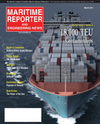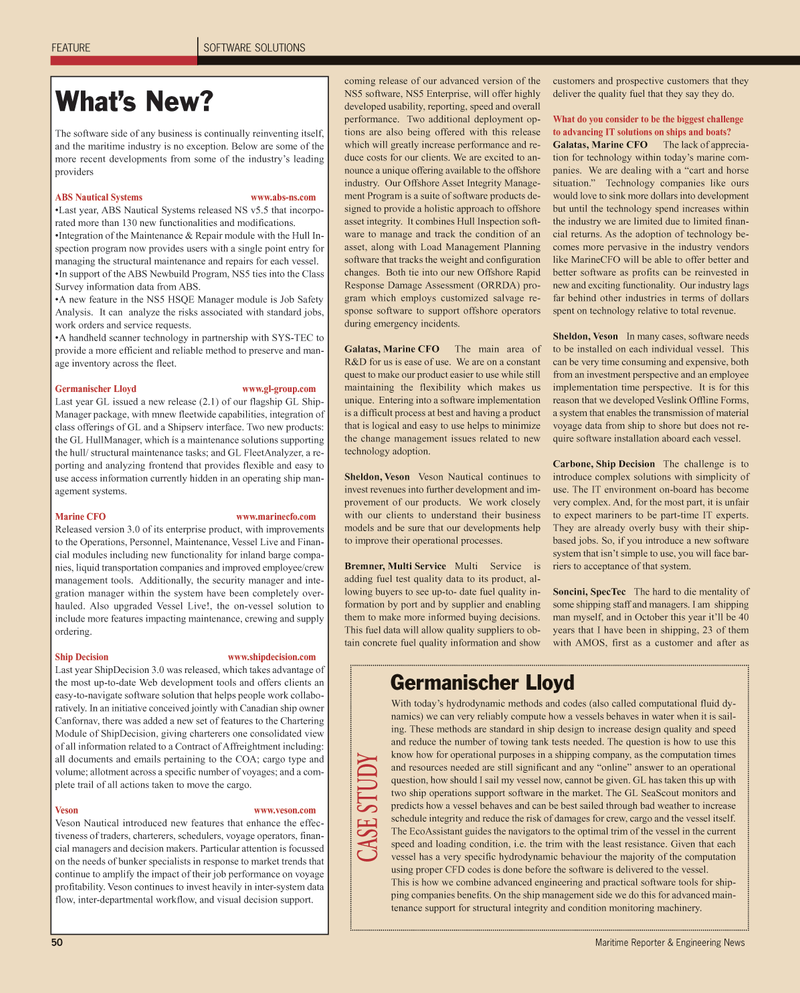
Page 50: of Maritime Reporter Magazine (March 2011)
Ship Repair & Conversion
Read this page in Pdf, Flash or Html5 edition of March 2011 Maritime Reporter Magazine
50 Maritime Reporter & Engineering News
FEATURE SOFTWARE SOLUTIONS coming release of our advanced version of the
NS5 software, NS5 Enterprise, will offer highly developed usability, reporting, speed and overall performance. Two additional deployment op- tions are also being offered with this release which will greatly increase performance and re- duce costs for our clients. We are excited to an- nounce a unique offering available to the offshore industry. Our Offshore Asset Integrity Manage- ment Program is a suite of software products de- signed to provide a holistic approach to offshore asset integrity. It combines Hull Inspection soft- ware to manage and track the condition of an asset, along with Load Management Planning software that tracks the weight and configuration changes. Both tie into our new Offshore Rapid
Response Damage Assessment (ORRDA) pro- gram which employs customized salvage re- sponse software to support offshore operators during emergency incidents.
Galatas, Marine CFO The main area of
R&D for us is ease of use. We are on a constant quest to make our product easier to use while still maintaining the flexibility which makes us unique. Entering into a software implementation is a difficult process at best and having a product that is logical and easy to use helps to minimize the change management issues related to new technology adoption.
Sheldon, Veson Veson Nautical continues to invest revenues into further development and im- provement of our products. We work closely with our clients to understand their business models and be sure that our developments help to improve their operational processes.
Bremner, Multi Service Multi Service is adding fuel test quality data to its product, al- lowing buyers to see up-to- date fuel quality in- formation by port and by supplier and enabling them to make more informed buying decisions.
This fuel data will allow quality suppliers to ob- tain concrete fuel quality information and show customers and prospective customers that they deliver the quality fuel that they say they do.
What do you consider to be the biggest challenge to advancing IT solutions on ships and boats?
Galatas, Marine CFO The lack of apprecia- tion for technology within today’s marine com- panies. We are dealing with a “cart and horse situation.” Technology companies like ours would love to sink more dollars into development but until the technology spend increases within the industry we are limited due to limited finan- cial returns. As the adoption of technology be- comes more pervasive in the industry vendors like MarineCFO will be able to offer better and better software as profits can be reinvested in new and exciting functionality. Our industry lags far behind other industries in terms of dollars spent on technology relative to total revenue.
Sheldon, Veson In many cases, software needs to be installed on each individual vessel. This can be very time consuming and expensive, both from an investment perspective and an employee implementation time perspective. It is for this reason that we developed Veslink Offline Forms, a system that enables the transmission of material voyage data from ship to shore but does not re- quire software installation aboard each vessel.
Carbone, Ship Decision The challenge is to introduce complex solutions with simplicity of use. The IT environment on-board has become very complex. And, for the most part, it is unfair to expect mariners to be part-time IT experts.
They are already overly busy with their ship- based jobs. So, if you introduce a new software system that isn’t simple to use, you will face bar- riers to acceptance of that system.
Soncini, SpecTec The hard to die mentality of some shipping staff and managers. I am shipping man myself, and in October this year it’ll be 40 years that I have been in shipping, 23 of them with AMOS, first as a customer and after as
What’s New?
The software side of any business is continually reinventing itself, and the maritime industry is no exception. Below are some of the more recent developments from some of the industry’s leading providers
ABS Nautical Systems www.abs-ns.com •Last year, ABS Nautical Systems released NS v5.5 that incorpo- rated more than 130 new functionalities and modifications. •Integration of the Maintenance & Repair module with the Hull In- spection program now provides users with a single point entry for managing the structural maintenance and repairs for each vessel. •In support of the ABS Newbuild Program, NS5 ties into the Class
Survey information data from ABS. •A new feature in the NS5 HSQE Manager module is Job Safety
Analysis. It can analyze the risks associated with standard jobs, work orders and service requests. •A handheld scanner technology in partnership with SYS-TEC to provide a more efficient and reliable method to preserve and man- age inventory across the fleet.
Germanischer Lloyd www.gl-group.com
Last year GL issued a new release (2.1) of our flagship GL Ship-
Manager package, with mnew fleetwide capabilities, integration of class offerings of GL and a Shipserv interface. Two new products: the GL HullManager, which ís a maintenance solutions supporting the hull/ structural maintenance tasks; and GL FleetAnalyzer, a re- porting and analyzing frontend that provides flexible and easy to use access information currently hidden in an operating ship man- agement systems.
Marine CFO www.marinecfo.com
Released version 3.0 of its enterprise product, with improvements to the Operations, Personnel, Maintenance, Vessel Live and Finan- cial modules including new functionality for inland barge compa- nies, liquid transportation companies and improved employee/crew management tools. Additionally, the security manager and inte- gration manager within the system have been completely over- hauled. Also upgraded Vessel Live!, the on-vessel solution to include more features impacting maintenance, crewing and supply ordering.
Ship Decision www.shipdecision.com
Last year ShipDecision 3.0 was released, which takes advantage of the most up-to-date Web development tools and offers clients an easy-to-navigate software solution that helps people work collabo- ratively. In an initiative conceived jointly with Canadian ship owner
Canfornav, there was added a new set of features to the Chartering
Module of ShipDecision, giving charterers one consolidated view of all information related to a Contract of Affreightment including: all documents and emails pertaining to the COA; cargo type and volume; allotment across a specific number of voyages; and a com- plete trail of all actions taken to move the cargo.
Veson www.veson.com
Veson Nautical introduced new features that enhance the effec- tiveness of traders, charterers, schedulers, voyage operators, finan- cial managers and decision makers. Particular attention is focussed on the needs of bunker specialists in response to market trends that continue to amplify the impact of their job performance on voyage profitability. Veson continues to invest heavily in inter-system data flow, inter-departmental workflow, and visual decision support.
With today’s hydrodynamic methods and codes (also called computational fluid dy- namics) we can very reliably compute how a vessels behaves in water when it is sail- ing. These methods are standard in ship design to increase design quality and speed and reduce the number of towing tank tests needed. The question is how to use this know how for operational purposes in a shipping company, as the computation times and resources needed are still significant and any “online” answer to an operational question, how should I sail my vessel now, cannot be given. GL has taken this up with two ship operations support software in the market. The GL SeaScout monitors and predicts how a vessel behaves and can be best sailed through bad weather to increase schedule integrity and reduce the risk of damages for crew, cargo and the vessel itself.
The EcoAssistant guides the navigators to the optimal trim of the vessel in the current speed and loading condition, i.e. the trim with the least resistance. Given that each vessel has a very specific hydrodynamic behaviour the majority of the computation using proper CFD codes is done before the software is delivered to the vessel.
This is how we combine advanced engineering and practical software tools for ship- ping companies benefits. On the ship management side we do this for advanced main- tenance support for structural integrity and condition monitoring machinery.
CASE STUD
Y
Germanischer Lloyd

 49
49

 51
51
